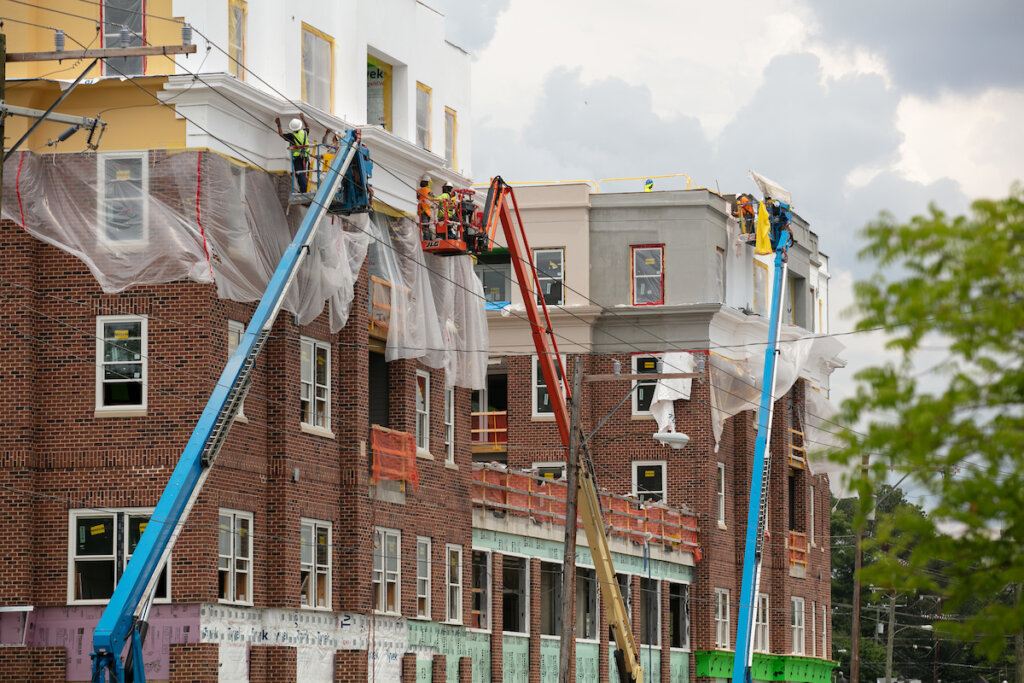
Building construction in Richmond, Va. A shortage of new homes is driving continued high housing costs, casting doubt on Virginia’s future growth. (Parker Michels-Boyce/Virginia Mercury)
Virginia will help fund housing construction near major business developments, Gov. Glenn Younkgin announced this week.
A new executive order, on the heels of an announcement about a major manufacturing development near Danville, sets a goal of investing $75 million towards localities that want to bolster housing supply tied to new job creation over the next five years.
“The private sector is ready to step in and meet the needs of our growing workforce with much needed workforce housing,” Youngkin said in a release announcing his order. “(This) announcement advances these efforts by accelerating workforce housing development and requiring local governments to support the housing growth that Virginia needs.”
How the funding will fuel housing supply
With a shortage of about 200,000 affordable housing units and a housing demand of about 4 million units overall, according to a study and state government analysis, the new investments aim to help foster construction.
Youngkin anticipates his new order can help create about 5,000 units.
As part of Executive Order 42, the Workforce Housing Investment Program will consist of loans, subsidies and grants for localities and nonprofits to develop new housing near new employers in regions of the state. It also states that localities planning to tap into the Virginia Business Ready Sites Program will need to provide housing plans to demonstrate how they can accommodate job growth.
One such example could be near the Berry Hill megasite in Pittsylvania County, which spans over 3,500 acres near Danville and has emerged as a development-ready site that could attract companies to the area. Ahead of Youngkin’s workforce housing announcement, Tennessee-based Microporous announced plans for a battery plant at the location that is slated to provide over 2,000 jobs.
Del. Danny Marshall, R-Danville, said in an interview this summer that he anticipated the area could be ripe for tapping into various funding opportunities to address the conflation of job growth and housing strains.
U.S. Senators, Richmond housing expert discuss how to ease nation’s affordable housing crisis
Macaulay Porter, a deputy communications director for the governor, noted that while the funding is going to be available statewide, “localities with the highest imbalance of job growth to housing” stand to benefit the most.
Analysis from the state’s housing department has indicated that feature typically applies to areas in Southwest Virginia.
Meanwhile, the Virginia Tobacco Region Revitalization Commission had also announced a workforce housing funding program over the summer. That pilot program has about $2 million in its coffers to disperse to applicants on a rolling basis.
Workforce housing pilot launches to support southern and southwestern Virginia
A Virginia Housing and Community Development study from 2022 noted how the state’s fastest growing regions over the previous decade were Northern Virginia, the Northern Shenandoah Valley and central Virginia’s Richmond. Conversely, rural areas of the state saw job losses. Those numbers could change in future census data as economic developments in rural areas attract or retain populations.
While some of her district entails urban areas, Sen. Lashresce Aird, D-Petersburg, previously told The Mercury that she anticipates rural portions of her district could benefit from workforce and housing development.
“Housing continues to be a big strain on how we’re going to get workers to come here,” she said.
With the 2025 legislative session on the horizon, lawmakers will continue to work on various other housing proposals — ranging from preserving existing affordable housing to rental assistance or protections, to support for ways localities can tap into federal housing development funds.
GET THE MORNING HEADLINES.

